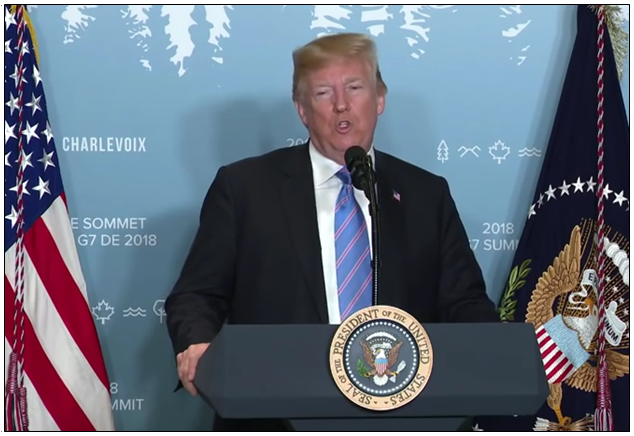“[N]o subsidies. I even said no tariffs… We have to — ultimately, that’s what you want. You want a tariff-free, you want no barriers, and you want no subsidies, because you have some cases where countries are subsidizing industries, and that’s not fair. So you go tariff-free, you go barrier-free, you go subsidy-free.”
That was President Donald Trump at the G7 summit in Canada on June 9, agreeing in principle to end all tariffs and subsidies on trade — when the rest of the world agrees to do the same.
Trump explained his position on the issue, “[T]United States has been taken advantage of for decades and decades, and we can’t do that anymore. We had extremely productive discussions on the need to have fair and reciprocal — meaning, the same. People can’t charge us 270 percent and we charge them nothing. That doesn’t work anymore.”
In other words, Trump says he’ll agree to lower U.S. tariffs and subsidies when others do the same. Trump may be onto something here.
Not only is this one of the reasons why Trump won the election in 2016 in the Rust Belt states.
In fact, modern accords on trade in the era, GATT, other free trade agreements and eventually the World Trade Organization, for all its warts, were brought about through reciprocal tariff reductions. The reason they had to be reciprocal was because that was the only way to get countries to lower their protectionist policies. They have to be sustainable both economically and politically.
That was how Smoot-Hawley was unwound, reciprocally. As more countries agreed to lower tariff walls, it became easier to reciprocate.
But there are all sorts of exceptions to the trade agreements. NAFTA still allows for lots of subsidies in tariffs in both directions, which routinely occur, and like other trade deals, does not address currency at all — which when devalued can be utilized as a subsidy to boost exports.
What Trump is proposing, very boldly, is that it doesn’t have to be that way anymore.
So, while the President’s critics point to tariffs enacted by the U.S., they run the risk of ignoring the larger point.
Everyone could abolish their tariffs. But it has to be together.
In many ways, it’s a corollary for how the President deals with other thorny issues around the globe. Take North Korea. There is no guarantee whatsoever that Kim Jong-un will agree to nuclear disarmament. That is, not without some reciprocal conditions.
It’s that act of walking around in the other country’s shoes that President Trump does so well.
To help bridge the gap, Trump offered security assurances for North Korea should they disarm. Trump said of Kim, in a post-nuclear North Korea, “He will be safe. He will be happy. His country will be rich. His country will be hard-working and very prosperous.”
That’s a huge carrot. Whether it is big enough remains to be seen. It might be better to have a treaty that ends the Korean War and deals with the nuclear disarmament issue in turn. Incrementally, the process can be achieved. But it will require concessions on both the North and South’s part to get there.
That is the essence of diplomacy. And Trump’s art of the deal.
Ultimately, not everything always works out with state to state relations around the world. But one thing is for sure, the world is a safer place when great powers cooperate to achieve great things. The only limit are our leaders’ visions for what is achievable domestically.
Trump, as a shrewd businessman, understands this all intuitively. That is why, on trade, fair and reciprocal reductions of tariffs, subsidies and other non-tariff barriers
And all the President’s critics in the G7 on tariffs are doing is exposing their own hypocrisy: “Free trade for thee but not for me.”
Robert Romano is the Vice President of Public Policy at Americans for Limited Government.







